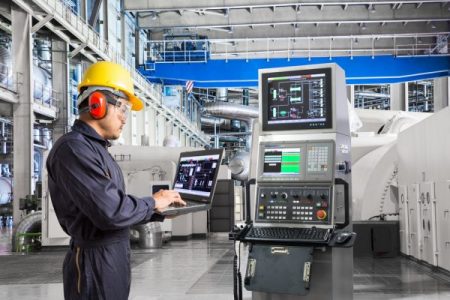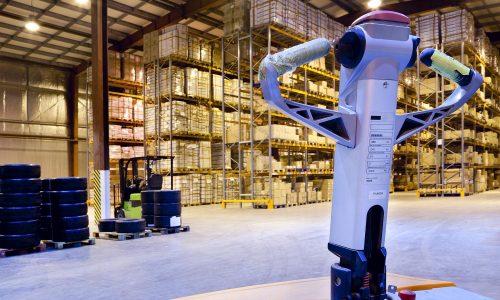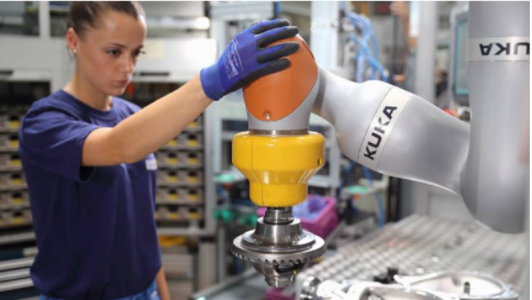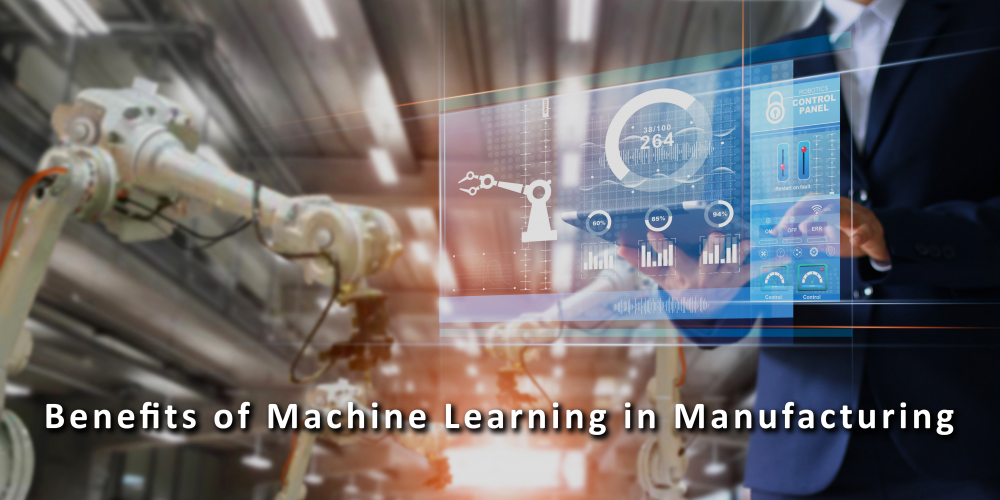Abstract: The cost of material accounted for high proportion of manufacturing. Therefore, factories have researched and investigated many ways to optimize the cost of material used in manufacturing. Nowadays, there are several techniques that have been applied to find out the optimal way of saving material. Machine Learning has been proved to be one of the most powerful techniques for optimizing energy use in manufacturing such as machines, equipment, engine. Moreover, Machine Learning also is used to improved production performance and quality. The computerization of industrial machinery is also undergoing rapid development. This article focuses on the benefits of Machine Learning in manufacturing such as predicting maintenance to decrease down-time, reducing maintenance cost, saving resources,.. and some specific success cases.
Machine learning in predictive maintenance

(Source: The Future Factory)
Predictive maintenance can help to determine the status of the equipment/machine in manufacturing and predict when the maintenance should be performed. By knowing exactly when the machine needs to be maintenance, the factory can greatly reduce down-time. Obviously, the implementation of Machine Learning solution can greatly save the cost and endure the stability of the equipment/machine. Deepsense.ai proved that they can reduce downtime BY 15%.
An automotive plant implemented a predictive maintenance solution for a hydraulic press used in vehicle panel production. Detailed studies of the maintenance process showed that engineers were spending far too much time attending to fix the machine/equipment instead of allocating resources for planned maintenance. Machine Learning solution allow engineer to predict equipment failure with high accuracy (up to 92%). So that they can have time to prepare for the maintenance effectively. Leading to overall equipment efficiency increased from 65% (the industry average) to 85%.
Another application from deepsense.ai show that a beverage industry manufacturer of industrial equipment fit their machines with a monitoring and prediction system to help engineers plan better preventative maintenance. The equipment usually based on time interval schedules rather than real needs. Sometimes it does not optimize too much. For that reason, it is better to maintain it on time.
Machine Learning in quality control

Using sensor with Machine Learning to detect anomaly (Source: Intel Company)
Quality control is integral to manufacturing processes, where defective products are weeded out from the rest, as early on in the production process as possible.
Machine learning is can be applied for product inspection and quality control. By using Machine learning algorithms, an embedded system can learn from a set of training/sample data to detect abnormally in manufacturing. In the past, the traditional way to detect abnormality is by using human eyes. However, it seems to be not effective because of time-consuming and costly.
According to deepsense.ai, In semiconductor manufacturing, the cost of testing and failures account for up to 30% of overall production costs. Forbes said that automated quality testing done with machine learning can increase detection rates by up to 90%.
In addition, A manufacturer of agricultural product packaging equipment applied Machine Learning to classify skin defects. With trusty data, the system can be taught the sorting platform to distinguish between different types of defect with high accuracy. The system combines software and hardware in order to reduce the complexity of the sorting process.
Integrating machine learning into the quality management process – often referred to as predictive quality – reduces quality issues and waste, cuts manufacturing costs, and minimizes product recalls to protect brand reputation.
Machine Learning in logistic and inventory management

(Source: Datafloq)
With growing complexity and interconnectivity in the supply chain industry, technology like artificial intelligence and machine learning has become central to logistics management.
With the development of machine learning algorithm, machine learning can handle and optimize complexity tasks in the supply chain industry. Because of the power of Machine Learning, computer can handle huge sets of data at a time unlike human computation. Machine learning can boost efficiency and reduce costs. Carefully considering and balancing all of these elements has used to be a human’s job. With the increasing amount of data reflected in each area, humans are not suitable anymore.
No business can run properly without a correctly maintained inventory. Both overstocking and understocking can be a detriment. With the right inventory management system, a business can simply concentrate on selling their product instead of managing its storage. Machine learning can help them to solve that problem.
Machine Learning in resource management

(Source: Avantech)
Computer architecture researchers have been investigating energy consumption for decades, especially to be able to deliver state-of-the-art energy efficient processors. Resource management is another strength of machine learning-based algorithms. The power consumption always is a problem in manufacturing. Manufacturer managers always want to reduce and save resource costs such as electricity, coal,…
One application is that Google applied in its data center cooling systems to reduce its electric bills– by up to 40%. That it was done without any infrastructure modernization or modification – the big data flowing through the system itself was enough – makes the feat all the more impressive.
Obviously, one of the greatest output for any factory is reducing electricity cost. While most factories operate 24 hours a day for optimal efficiency, it’s possible to schedule more energy-intensive activities for suitable times. The idea is to ensure those activities occur when power is cheapest. Depending on source, this could be during the day (if solar power is prominent) or during the night (when demand is generally lower).
When it comes to consuming energy, it is often the case that we maintain our habits and behaviors until something unexpected happens. For instance, higher electricity bills than usual, or lower-than-expected performance from renewable energy sources. That is why machine learning has an important role. By processing energy consumption data (usually historical data), it is possible for a model to review trends and patterns and predict future energy consumption.
In economic, the benefit of energy consumption forecasting help company or factory can convert energy into cost, and therefore estimate energy bill help to make decisions based on that. Another benefit in practical is that by not only knowing how much energy the machine/equipment will consume but understanding how the other feature correlates with energy, we can optimize energy consumption without affecting our productivity.
In conclusion, you can more precisely determine where such investments make sense, use your resources more strategically, and get more out of your factories.
Robotics

LBR iiwa of KUKA company (Source: KUKA Company)
In the near future, some of the most well-known collaborators for manufacturers are getting smarter with machine learning: robots. Because of some complex and dangerous tasks, the use of artificial intelligence allows them to take on those tasks. These new robots surpass the assembly lines that they once were relegated to, as their Machine Learning capabilities allow them to tackle more complicated processes than before.
KUKA, a Chinese-owned German manufacturing company, is aiming at using industrial robots. Their goal is to create a robot that can work alongside humans and act as collaborators. This company uses their robot which is called LBR iiwa into the fold. This intelligent robot is equipped with high-performance pressure sensors that allow it to perform complicated tasks while working beside humans and learn how to improve their productivity.
KUKA itself uses its robots in its factories, but there are other major manufacturers that do so as well. Another is that BMW, which is the famous auto brand, is one of its biggest customer, and one of the businesses that’s already finding that robots can reduce human-related errors, boost productivity and add value throughout the entire manufacturing chain.
Conclusion
In conclusion, machine learning is very useful and effective in manufacturing since it appears in many stages in the factory. Increased productivity, reduced equipment failures, better distribution resources are just a few of the perceived benefits of using machine learning in manufacturing. Machine learning can reduce costs and resource in many areas and many stage. The flexibility of this technology explains its rise in popularity as it has become more user friendly. For decades, manufacturers have been early adopters of all kinds of technologies, from automation to robotics, and sophisticated digital solutions. Nowadays, more and more factories use machine learning in their manufacturing to empower their process. Year after year, more case studies and research reports get published, provide evidences for its benefit. The challenge is how to apply it to your business/factory. Thanks for reading this article. If you have any question, feel free to contact us at Email: info@daviteq.com


 Tiếng Việt
Tiếng Việt




Comments are closed.